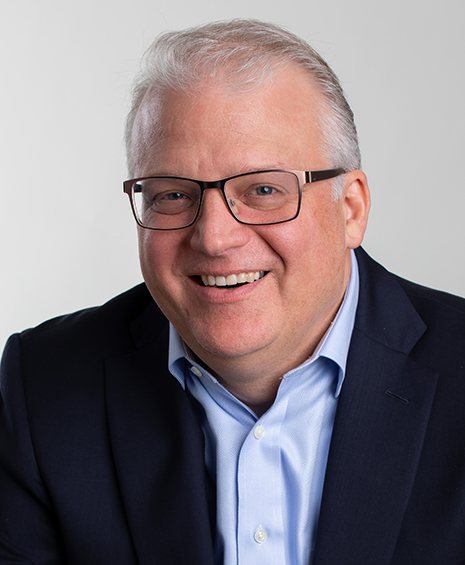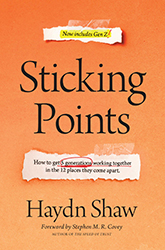
$5,001 - $7,500
Keynote fee falls within this range. For exact fee, please contact us.
Illinois
Request Availability for Haydn Shaw
Haydn Shaw has helped managers and organizations raise their generational IQ so they can deal with the multigenerational workforce for over twenty-five years. He is the author of Sticking Points: How to Get 5 Generations Working Together in the 12 Places They Come Apart and the best-selling workshop Leading Across Generations and Working Across Generations. He also writes on generations and leadership for the Huffington Post.
TIME wrote, “Shaw is an expert on cultural differences at the office.” He has spoken to over 100,000 people and worked with more than 1,500 businesses (from Fortune 500 companies to start ups), not-for-profit organizations, and governmental agencies. The results from his long-term organizational development and change projects have been written up in case studies. His simple process helps organizations cut generational turnover, get serious about knowledge transfer before the boomers head out the door, and quit losing sales because they don’t know how to speak the language of their customers.
Shaw has taught thousands of ag students and has helped thousands of farmers, ranchers and over 150 agricultural organizations get better results from their people. Haydn raises people raise their generational IQ so they can motivate, cut resignations, and find good people in this scarce hiring pool. His family has raised cattle and farmed land in the Wabash Valley for almost 200 years, so he understands multigenerational family farming.
Known for taking groups from hilarity to deep reflection, he combines rich content with use-tomorrow tools. His work makes an impact because he does his homework, customizing each speech so that they drive results. Haydn connects with virtually any group in any industry and brings practical and inspiring examples from the boardroom and the front line.
Hailed as a “leadership guru” by the Washington Post, Haydn speaks and consults over 100 days each year to clients who invite him back.
Sticking Points: How to Get the 4 Generations Working Together in the 12 Places They Come Apart
They’re here. For the first time in history, you have four generations in your workplace and five generations as customers. Today you have to understand Traditionalists, Baby Boomers, Gen Xers, and Millennials just to write an email that won’t make someone angry. These generations think differently, vote differently, buy differently, and dress differently. Not understanding these differences creates conflicts and loses sales. You will learn:
- What the differences are among the generations
- What sticking points the differences create for organizations, teams, and even families
- How marketing approaches must change to reach the younger generations
- What attracts and keeps younger employees
- How these differences will complicate the mass exodus of the Boomers from the full time workforce over the next decade
This popular session is full of laughter and insight. Come and see yourself, your customers, your people and your future – and walk away with practical ideas and plans for increasing your ability to get things done across the generations.
How to Speak Millennial and Get Better Results Managing All Your Generations
The newest generation – the Millennials (ages 14-34) – are here, and the Traditionalists, Baby Boomers, and Generation Xers only know one thing: it’s not business as usual. From their multitasking to their smartphones, the text message generation has a different approach. Organizations that figure out how to attract them, adjust to them, and retain them now will jump far ahead of those that ignore them until they make up half the workforce in 10 years. This presentation will make you laugh, cry, and walk out with use-today ideas. You will learn:
- The secret to understanding Millennials.
- Why half of the criticisms older generations bring against Millennials are just them being grouchy.
- The five things the Millennials misunderstand about the older generations and what to do about it.
- Five ideas you can implement tomorrow to better motivate Millennials.
- The one conversation Millennials complain their boss is too scared to have.
In the words of a thirty year boomer employee, “Before this presentation, I resented the Millennials for wanting things now that took me years to work for. But now, I understand how different their world was from mine and I can’t wait to understand them better so I can really enjoy working with them. Plus, this had really helped me understand my own kids. I’m going to talk with them differently tonight.”
Stop Losing Half of Your Sales: How to Traditionalists, Baby Boomers, Gen Xers, and Millennials
They’re here. For the first time in history, you have four generations in your workplace and five generations as customers. Today you have to understand Traditionalists, Baby Boomers, Gen Xers, and Millennials just to write an email that won’t make someone angry. These generations think differently, vote differently, buy differently, and dress differently. Not understanding these differences creates conflicts and loses sales:
- What are the differences between generations?
- How do we market to the younger generations when they have a different focus than the Boomers did at their age?
- What issues do the differences create for teams or even families?
This popular session is full of laughter and insight. Come and see yourself, your customers, your colleagues, and your future. In this session you will:
- Learn if you “get it.” You’ll discover if you are being unconsciously rude to other generations.
- You will understand generational differences so you will know when you are taking another generation’s behavior too personally.
- They’ll get specific ideas for how to adjust your approach so you can become a trusted advisor to each of the generations.
Leading Through the 6 Change Reactions: Why Change Stalls and What You Can Do About It
When they announce changes, leaders tell their people that change is now a fact of life. But there is another fact of life: people respond to change in six ways. When leaders and managers ignore the 6 Change Reactions, they make change harder than it needs to be. But you and your leaders can create a change wave rather than struggle to push the change forward.
This humorous, fast-paced session presents a breakthrough approach to change. You’ll understand The 6 Change Reactions and…
- Why change programs backfire
- Why trying to help people change is keeping them from changing
- How to map your team or organization on the 6 Change Reactions curve
- Why many change teams die a slow death after going in circles until the forward thinking people disengage
- How to set up a team for a quick start
- How to find and train change sales people who can convince the critical few that will move the change forward
- How to help the three negative reactors use their negativity to speed things up rather than bog them down
- How to deal with the one percent hard core resisters so they don’t ruin everything
You’ll never look at your people the same way again, and they will love you for it.
Request Availability for Haydn Shaw
HAYDN SHAW

Illinois
$5,001 - $7,500
Keynote fee falls within this range. For exact fee, please contact us.
Haydn Shaw has helped managers and organizations raise their generational IQ so they can deal with the multigenerational workforce for over twenty-five years. He is the author of Sticking Points: How to Get 5 Generations Working Together in the 12 Places They Come Apart and the best-selling workshop Leading Across Generations and Working Across Generations. He also writes on generations and leadership for the Huffington Post.
TIME wrote, “Shaw is an expert on cultural differences at the office.” He has spoken to over 100,000 people and worked with more than 1,500 businesses (from Fortune 500 companies to start ups), not-for-profit organizations, and governmental agencies. The results from his long-term organizational development and change projects have been written up in case studies. His simple process helps organizations cut generational turnover, get serious about knowledge transfer before the boomers head out the door, and quit losing sales because they don’t know how to speak the language of their customers.
Shaw has taught thousands of ag students and has helped thousands of farmers, ranchers and over 150 agricultural organizations get better results from their people. Haydn raises people raise their generational IQ so they can motivate, cut resignations, and find good people in this scarce hiring pool. His family has raised cattle and farmed land in the Wabash Valley for almost 200 years, so he understands multigenerational family farming.
Known for taking groups from hilarity to deep reflection, he combines rich content with use-tomorrow tools. His work makes an impact because he does his homework, customizing each speech so that they drive results. Haydn connects with virtually any group in any industry and brings practical and inspiring examples from the boardroom and the front line.
Hailed as a “leadership guru” by the Washington Post, Haydn speaks and consults over 100 days each year to clients who invite him back.

